Deciding on the ideal number of sets and reps to promote hypertrophy (increasing muscle size) can be confusing for beginners. Doing 3 sets of 15 reps (3 x15) is a popular way to lift weights, but is it effective for building muscle?
3 x 15 is a popular and effective rep range for hypertrophy. Bodybuilders commonly use it to tone and define specific muscles, whilst beginners can use it to safely start lifting weights. This style of training is most effective when applied to small isolation-type movements like the bicep curl.
Below, I explain what 3 x 15 is and share the scientific evidence to show that it’s effective to get bigger muscles.

Key Takeaways
- 3 x 15 is a popular training style that can be used by beginners and trained lifters alike.
- This is a moderately high rep range that is effective for hypertrophy as well as toning and defining specific muscles.
- It’s best applied to isolation-type movements like the bicep curl.
- Beginners can also do 3 x 15 for compound movements like the squat and bench press to start building muscle.
What Do 3 Sets Of 15 Reps Mean?
3 sets of 15 reps are also known as 3 x 15. This describes an exercise being repeated 15 times before resting for a short duration to complete a set. And this is completed for 3 sets. A 3 x 15 workout involves performing each exercise in this manner.

Thus, 3 sets of 15 reps describe how you perform each exercise in your workout.
In a 3 x 15 dumbbell bench press example, you would repeat the exercise 15 times to complete the set.
You would then rest before moving on to the next set. And this would be repeated for 3 sets before moving on to the next exercise in your workout.
You can find out what constitutes a set and a rep below.
Definition Of 3 Sets
A set refers to completing an x-number of consecutive reps and then taking a break. Doing 3 sets, therefore, means repeating this 3 times.
The break is important.
It gives your muscles the chance to recover to exert themselves in the next set.
Rest durations vary but they typically last for 1-3 minutes.
This can be even shorter or longer depending on the type of workout you’re performing.
Programs that are designed to maximize strength, power, and muscle growth usually incorporate longer rest durations, whilst fat-burning workouts usually utilize shorter rest durations.
Definition Of 15 Reps
Doing 15 reps simply mean repeating an exercise 15 times.
A “rep” is shorthand for “repetition” (1 complete movement of a given exercise).
Each rep can be further dissected into a concentric and eccentric phase.
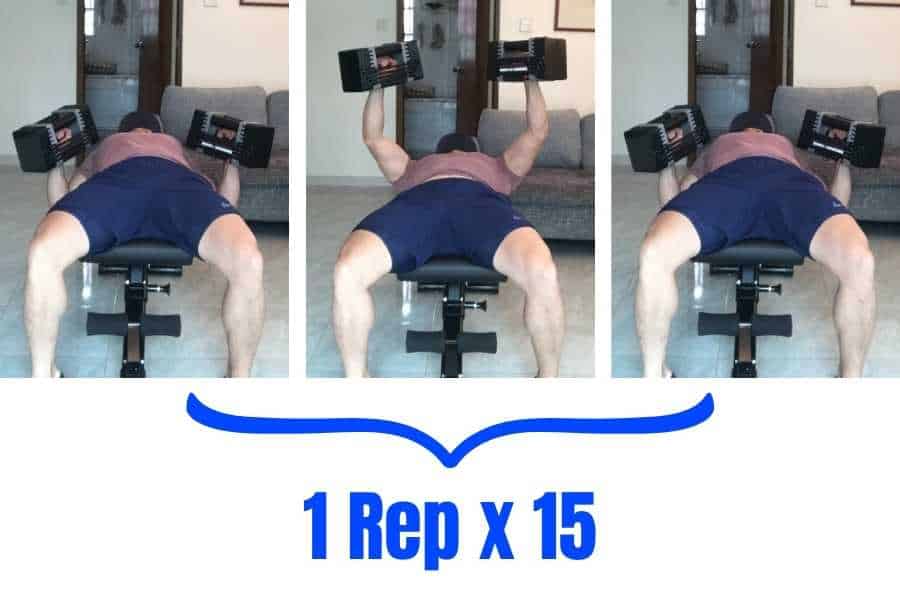
The concentric phase describes the shortening phase of a muscle contraction. In a bench press example, this is the positive portion of the movement where you lift the weight upward.
The eccentric phase describes the shortening phase of a muscle contraction. In a bench press example, this is the negative portion of the movement where you bring the weight down.
Thus, a rep comprises a concentric and eccentric phase.
Why Do Sets And Reps Matter?
Reps and sets form the building blocks of your training program.
When you combine your total weekly sets and reps (together with the weight lifted) you get your total training volume. In other words, the total amount of work performed.
And training volume in turn dictates the results you get from your workouts.
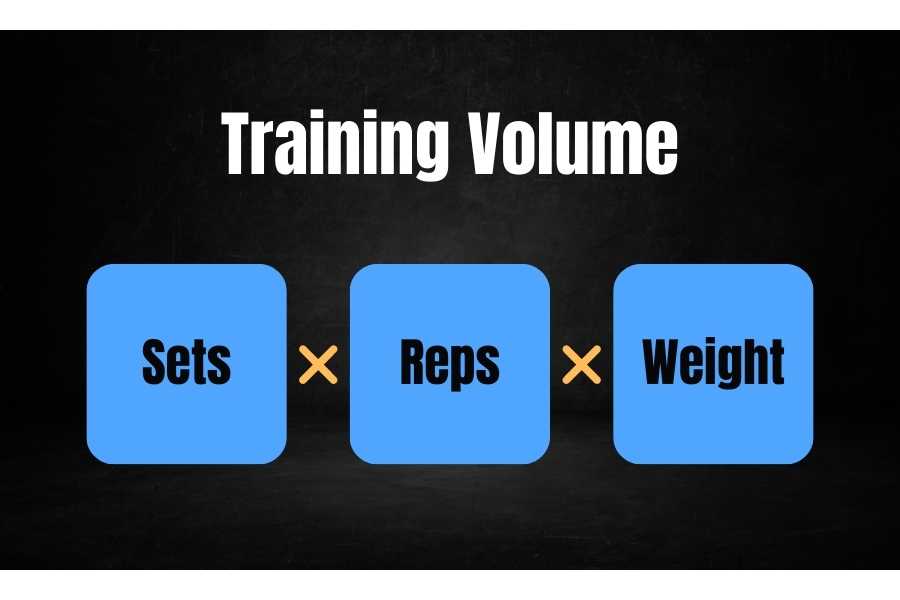
There are different ways to structure your reps and sets, each being ideal for different muscle-building goals. Common examples are shown below:
| Training Goal Emphasis | Sets | Reps | Rest Between Sets | Weight |
|---|---|---|---|---|
| Hypertrophy | 3-5 | 15+ | 30-60 seconds | 40-60% of 1RM |
| Balanced | 3-4 | 8-12 | 30-90 seconds | 70-80% of 1RM |
| Strength & power | 3-5 | 3-6 | 2-5 minutes | 85-95% of 1RM |
Note: 1RM stands for 1-rep max. If you don’t know what this means, you can find a full explanation in my guide to choosing the best weight to build muscle.
Some people like to perform high reps using a lighter weight (e.g. 3 sets of 15) to get a good pump and increase muscle size (hypertrophy).
Others prefer doing low reps with heavy weights (e.g. 5 sets of 5) to build strength and power.
Yet others use moderate reps and a medium weight for a balance between muscle size and strength gains.
Thus, 3 x 15 is just one of many ways you can lift weights to gain muscle.
Muscle-Building Benefits Of 3 Sets Of 15 Reps
3 x 15 workouts can be good for people of all training levels to build muscle. Here are the main benefits of doing 3 sets of 15 reps:
1) Ideal for isolation-type exercises.
These are movements that target specific muscle groups. Popular examples include:
- Bicep curls (check out my other post for a complete guide to bicep growth).
- Tricep extension.
- Lateral raise.
- Chest fly.
- Reverse fly.
- Leg curl.
- Leg extension.
- Ab exercises.
These exercises recruit smaller muscle groups compared to the bigger compound exercises.
As a result, they lend benefit from the lighter weights used in 3 x 15 training. This allows you to maintain good form and get the maximum squeeze in the target muscle.
2) Great for getting a muscle pump.
A pump refers to the “swole” feeling you get in your muscle after training. Extended durations of muscle contraction and an increased blood flow to the target muscle is the main reason why this happens.
Working in moderately high rep ranges (such as 15 reps) is a great way to maximize this effect.
It’s for this reason that bodybuilders commonly favor doing high reps for arms.
3) Good for toning muscles.
Muscle tone visibility relies on your muscles being in a contracted state during rest.
The greater the contracted state, the more visible your tone (assuming you also have a low body fat percentage).
Since the 15-rep range is good for getting a muscle pump, it’s also great for toning specific muscles.
I personally love doing 15-rep bicep and tricep workouts to highlight my arms.
4) Safe for beginners to start lifting weights.
Skinny guys are usually recommended to lift heavy for low reps in order to build muscle fast.
But heavy lifting can be intimidating and even dangerous.
Working in the 15-rep range entails lifting lighter weights to reach the same training volume compared to working in a low-rep range (e.g. a 5-rep range).
This makes 3 x 15 workouts great for newbies to safely begin a weight training program and start building muscle.
5) Less weight means lighter joint load.
Extending from the previous point- lifting lighter weights puts a less physical load on your joints.
This is important because, as a beginner, your joints are typically weaker than an experienced lifter.
This means doing 3 sets of 15 reps is great for beginners to start lifting weights safely and comfortably.
If you’re new to weight training, you may be interested in the research I conducted which revealed the hardest and easiest muscles to build.
Studies Showing 3 Sets Of 15 Reps Can Build Muscle
Traditionally, the ideal training volume for muscular hypertrophy is considered to be 3 or 4 sets of 6-12 reps.
Additionally, most people would argue that the higher the rep range the less emphasis on muscle growth and the greater emphasis on muscular endurance.
So does that mean 15 reps- considered to be a relatively high rep range- is too much for optimal muscle hypertrophy?
Not quite.
Below, are 3 scientific studies that show 3 x 15 training can effectively build muscle.
Case Study 1:
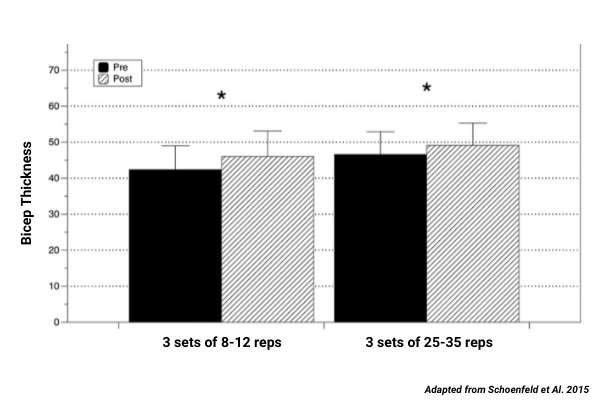
This 2015 study compared two groups of men who performed different compound pushing/pulling/leg exercises:
- Group 1- completed 3 sets of 8-12 reps per workout using a heavy weight.
- Group 2- completed 3 sets of 25-35 reps per workout with a light weight.
Both groups completed 3 workouts per week for 8 weeks. The scientists then measured the subject’s bicep, tricep, and quadricep thickness.
What did they find?
Both the high-rep and low-rep groups saw similar muscle gains overall. Furthermore, the high-rep group saw even bigger gains in their biceps compared to the low-rep group!
Case Study 2:
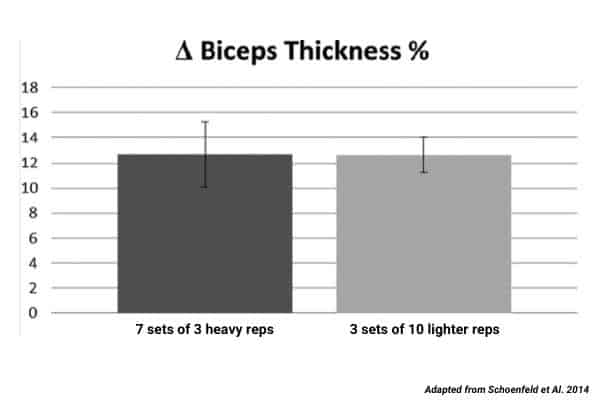
This 2014 study compared two groups of men who performed different compound pushing/pulling/leg exercises:
- Group 1- completed 7 sets of 3 reps per workout with a heavy weight.
- Group 2- completed 3 sets of 10 reps per workout with a light weight
The scientists then measured bicep diameter after 8 weeks.
What did they find?
Again, bicep diameter increased by similar amounts in both groups!
Case Study 3:
This 2016 study compared two groups of men who performed compound pushing and leg exercises:
- Group 1- completed 3 sets of 10 reps per workout with a heavy weight.
- Group 2- completed 3 sets of 20 reps per workout with a light weight
The scientists then measured total muscle mass after 12 weeks of training.
What did they find?
Once again, both groups saw similar increases in muscle mass.
3 x 15 Example Workout
Below, you’ll find an example 3-day full-body 3 x 15 workout for beginners to build muscle.
Monday:
| Exercise | Sets | Reps |
|---|---|---|
| Goblet squat | 3 | 15 |
| Dumbbell chest fly | 3 | 15 |
| Dumbbell row | 3 | 15 |
| Shoulder press | 3 | 15 |
| Dumbbell deadlift | 3 | 15 |
| Bicep curl | 3 | 15 |
Wednesday:
| Exercise | Sets3 | Reps |
|---|---|---|
| Goblet squat | 3 | 15 |
| Dumbbell bench press | 3 | 15 |
| Reverse dumbbell fly | 3 | 15 |
| Shoulder press | 3 | 15 |
| Dumbbell deadlift | 3 | 15 |
| Dumbbell sit-ups | 3 | 15 |
Friday:
| Exercise | Sets | Reps |
|---|---|---|
| Goblet squat | 3 | 15 |
| Dumbbell bench press | 3 | 15 |
| Dumbbell row | 3 | 15 |
| Lateral raise | 3 | 15 |
| Dumbbell deadlift | 3 | 15 |
| Tricep extension | 3 | 15 |
You can use my signs of muscle growth to help you determine if your workouts are actually working.
Rest:
For hypertrophy training, it’s recommended to rest 3-6x the amount of time it takes you to complete each set.
A good general recommendation for 3 sets of 15 reps is to rest for 2 minutes between each set.
Additionally, ensure 24-48 hours of rest between workouts to allow for full muscle recovery. This can be achieved with 3 workouts per week.
Weight:
The ideal weight to use for 3 sets of 15 reps is one that challenges and fatigues the target muscle, but not so heavy that you can’t complete your allotted 15 reps with good form.
For most people, this equates to a weight that is ~60% of your 1RM for each exercise.
You can find my exact weight recommendations here.
Workout Duration:
Each workout should take around 45 minutes to complete. Generally speaking, workout times should not last longer than 1 hour for a beginner.
How Many Sets And Reps Are Ideal For Hypertrophy?
In general, I recommend sticking to the training volume recommendations given in the earlier section “Why Sets And Reps Matter”:
To recap- that’s between 3-5 sets of 3-15 reps.
These are the most popular rep ranges adopted for building muscle.
How Many Weekly Sets Does The Average Person Do?
Now let’s take a look at how many sets the average person does at the gym.
To do so, I tracked down 3 Reddit polls:
- How many sets per workout?
- How many sets do you do per workout?
- What’s the average number of sets you do per workout?
And here are the results:
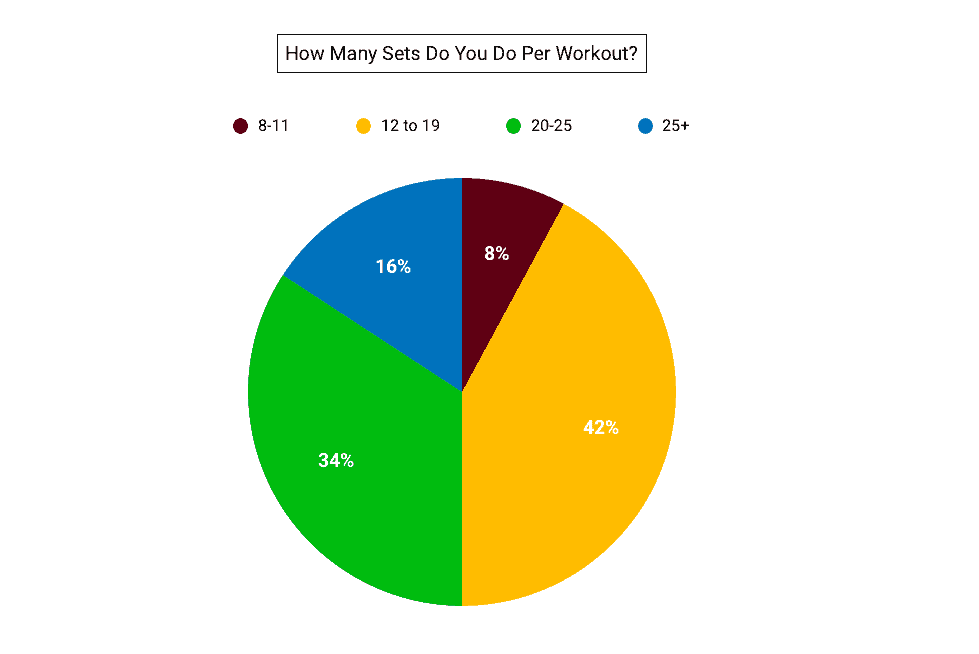
As you can see, the average person does 12 to 25 sets per workout.
Assuming each workout is a whole-body session (6 muscle groups being the chest, arms, shoulders, abs, back, and legs), that equates to around 2 to 4 sets per muscle group.
So if you’re doing 3 sets per muscle group, then you fall slap bang in the middle of the average!
How Many Sets Should You Do Per Workout?
In general, aim for 3 to 4 sets per muscle group per training day for 3 training days per week.
This satisfies the training volume required for muscle hypertrophy. 5 sets per training session are also acceptable, but it is not recommended to do more than 5 sets per session.

Why 3 to 4 sets?
Firstly, this 2015 study consistently found a dose-response relationship in the bench press, shoulder press, lat pull down, and leg press.
In this study, each exercise was performed for 1, 3, and 5 sets per workout. And the scientists found that the more sets performed the bigger the muscle gains.
So why stop at 4 sets? Why not do more? Say 5, or 6, or 7+ sets?
Well, this 2018 study also found that hitting a muscle group with more than 5 sets per workout does not produce added benefits.
Findings suggest performing >5 sets per exercise does not promote greater gains in muscle strength and hypertrophy.
Hackett et al. 2018
In other words- anything more than 5 sets becomes wasted “junk sets”.
So aim for 3 to 4 sets per muscle group per workout and save yourself from wasting time and energy on unnecessary sets!
Taken together- 3 to 4 sets per muscle group per workout is recommended, 5 sets are pushing it, and more than 5 sets are unnecessary.
How Many Sets Per Week?
It is recommended to do 60 to 90 sets per week to work the whole body.
This equates to 10 to 15 sets per muscle group per week. Doing less than 60 sets per week will not maximize hypertrophy and doing over 90 sets per week is too much.
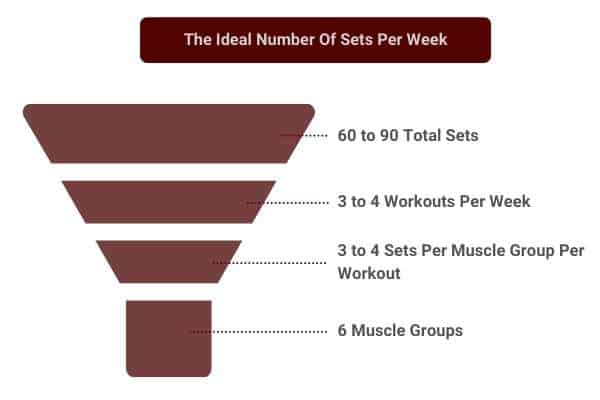
This recommendation assumes 6 major muscle groups, 3 to 4 sets per muscle group per workout, and 3 to 4 workouts per week:
- 6 muscle groups x 3 sets per workout x 3 workouts per week = 54 sets
- 6 muscle groups x 4 sets per workout x 4 workouts per week = 96 sets
Based on the calculations, my recommendation comes out to 54 to 96 total weekly sets.
But I rounded it down to 60 to 90 weekly sets to be in line with Meno Henselman’s recommendation for 10 to 15 sets per muscle group per week.
60 to 90 weekly sets could be split as follows:
- Chest- 4 sets of 8 reps x 3 weekly workouts = 12 sets
- Shoulders 4 sets of 8 reps x 3 weekly workouts = 12 sets
- Arms- 3 sets of 15 reps x 3 weekly workouts = 9 sets
- Abs- 3 sets of 15 reps x 3 weekly workouts = 9 sets
- Back- 4 sets of 8 reps x 3 weekly workouts = 12 sets
- Legs- 4 sets of 8 reps x 3 weekly workouts = 12 sets
Total = 66 sets per week
Conclusion
3 sets of 15 reps is a popular and effective training style to build muscle.
It involves doing 15 consecutive repetitions to complete a set before taking a break and repeating this for 3 sets.
3 x 15 is best used with small isolation-type movements to tone and define muscles. But it can also promote hypertrophy when applied correctly.
Beginners can also find this rep range to be a safe way to start lifting weights.
You may also be interested in the downloadable Kalibre Blueprint PDF which details exactly how I gained 40lbs of lean muscle (it’s 100% free!). It details the exact exercises and nutrition (with printables) I used to go from skinny to ripped!


